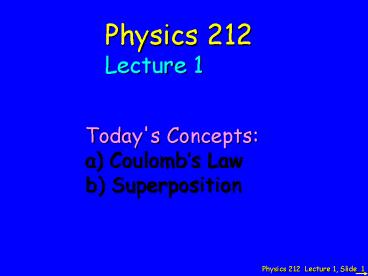Physics 212 Lecture 1, Slide 1 PowerPoint PPT Presentation
1 / 30
Title: Physics 212 Lecture 1, Slide 1
1
Physics 212 Lecture 1
Today's Concepts a) Coulombs Law b)
Superposition
2
Physics 212 The Course
NEW NEW NEW NEW Prelectures Lectures (50
minutes)
http//online.physics.uiuc.edu/courses/phys212
3
Index
Extra 1
Extra 2
Extra 3
Extra 4
Extra 5
4
Preflight 1
The force acting on the smaller particle on the
left is caused by the particle on the right, so
the vector representing this force would be about
10x longer than the vector representing the force
present on the bigger particle.
B
C
A
BACK
5
Preflight 2
BACK
6
Preflight 3
simulation
BACK
7
Preflight 4
A
B
C
8
Preflight 4
BACK
9
Levitation
- A charged ball Q1 is fixed to a horizontal
surface as shown. When another massive charged
ball Q2 is brought near, it achieves an
equilibrium position at a distance d12 directly
above Q1. - When Q1 is replaced by a different charged ball
Q3, Q2 achieves an equilibrium position at
distance d23 (lt d12) directly above Q3.
d12
d23
g
Q3
A) The charge of Q3 has the same sign of the
charge of Q1 B) The charge of Q3 has the
opposite sign as the charge of Q1 C) Cannot
determine the relative signs of the charges of Q3
Q1
10
Levitation
- A charged ball Q1 is fixed to a horizontal
surface as shown. When another massive charged
ball Q2 is brought near, it achieves an
equilibrium position at a distance d12 directly
above Q1. - When Q1 is replaced by a different charged ball
Q3, Q2 achieves an equilibrium position at
distance d23 (lt d12) directly above Q3.
d23
d12
g
Q3
A) The magnitude of charge Q3 lt the magnitude of
charge Q1 B) The magnitude of charge Q3 gt the
magnitude of charge Q1 C) Cannot determine
relative magnitudes of charges of Q3 Q1
BACK
11
Three Charges I
- Two balls, one with positive charge Q and the
other with positive charge 2Q, are held fixed at
a separation of 3m. - A third ball with non-zero charge q is placed
between the first two balls as shown.
2m
1m
q
Q
2Q
- Which of the following statements is true?
- The force on q can be zero if q is positive.
- The force on q can be zero if q is negative.
- The force on q can be never be zero, no-matter
what its charge is.
BACK
12
Balloons
- Take two balloons and rub them both with a piece
of cloth. After - you rub them they will
- Attract each-other
- Repel each-other
- Either it depends on the material of the cloth
13
Balloons
- If the same thing is done to both balloons they
will acquire the same sign charge. - They will repel !
BACK
14
Car-Bug
- You are driving down the highway one summer day
when a bug spatters on your bumper. During the
car-bug collision, the magnitude of the force
acting on the bug is FB and the magnitude of the
force acting on the car is FC. - Which of the following is true?
- A) FB gt FC
- B) FB FC
- C) FB lt FC
15
Car-Bug
FB FC
Newtons Third law
BACK
16
Coulombs Law
q1
q2
Your job is to figure out the vector version
Coulombs Law formula given what you know about
the direction of the force. Our notation will be
that F1,2 is the force by 1 on 2 (think by-on
) and that r1,2 is the vector that points from 1
to 2.
A)
and
B)
and
C)
and
D)
and
17
Coulombs Law
Suppose q1 and q2 are both positive. - They
will repel - The force on q2 will be to the
right (same direction as r1,2)
q1
q2
18
Coulombs Law
Suppose q1 is negative and q2 is positive. -
They will attract - The force on q2 will be to
the left (opposite direction as r1,2)
-
q1
q2
BACK
19
Three Charges II
- In which of the cases shown below is the net
force on the center charge the largest? Red and
Blue denotes negative and positive, and the size
of the circle represents the magnitude of each
charge.
20
Three Charges II
BACK
21
Superposition
If there are more than two charges present, the
total force on any given charge is just the
vector sum of the forces due to each of the other
charges
22
What if the sign of q1 changes?
The direction of all forces changes by 180o the
magnitudes stay the same
q1
BACK
23
Charges on Strings
Two balls of equal mass are suspended from the
ceiling with nonconducting wire. One ball is
given a charge 3q and the
other is given a charge q.
24
Charges on Strings
Which best represents the equilibrium position?
3q
- Remember Newtons Third Law!
- F31 -F13
- Can we solve this quantitatively?
- How do we start?
25
Charges on Strings
How do we solve this quantitatively?
- Concept What Principle/Law(s) do we use?
- Strategy What are the unknowns?
- Quantitative What are the equations?
BACK
26
Ad Lib 1
BACK
27
Ad Lib 2
BACK
28
Ad Lib 3
BACK
29
Ad Lib 4
BACK
30
Ad Lib 5
BACK

